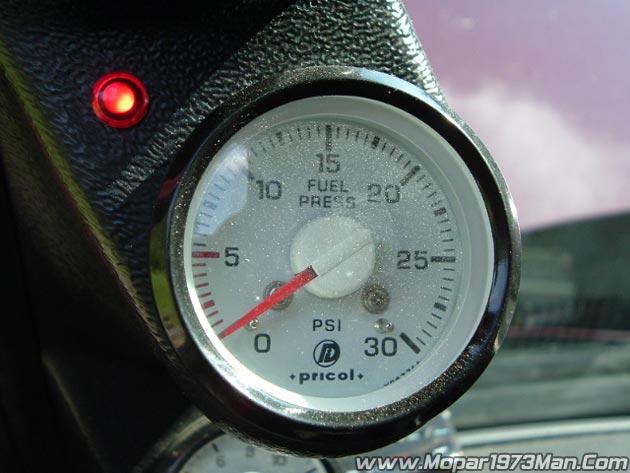Gauges

There are several brands of gauges available for diesel engines. The four most important gauges for a Dodge Cummins truck are:
1. Fuel Pressure
2. Pyrometer
3. Boost Pressure
4. Transmission Temperature (Automatic Transmission)
Fuel Pressure
Here is a typical setup for a stock fuel system for tapping the bottom of the fuel filter housing.

Here is the basic fuel tap part used above. The needle valve is a Weatherhead Part number WH6820 usually sold at NAPA part stores for about $8 bucks.

Here is my current setup used on my AirDog 150 fuel system. The fuel pressure tap is the old school Vulcan Big Line kit in the mid point of the stock fuel filter and the Bosch VP44 injection pump. Then the needle valve is first on foremost to protect everything down line from there.

I installed my fuel pressure gauge by using a tapped banjo bolt. The lower picture shows the hardware used to plumb the fuel pressure gauge. There is NOT AN ISOLATOR in my system, but I do have a needle valve to shutdown the fuel flow if a leak occurs.
A free banjo bolt is included in the Cummins Campaign Pump kit. The order number for the needle valve from NAPA is: Weather head (WH6820). The nylon tubing kit can be found at any local parts store in the oil pressure gauge plumbing kits.
I found at my local NAPA store polyon air brake line in 1/8" size. This stuff is super flexible and super tough. You can use this stuff for you boost gauge and fuel pressure gauge without any problems. This tubing is fuel and oil rated so it will not break down with fuel or oil exposure. Much stronger than the cheap nylon oil pressure kits as mentioned above.

Now there has been several people get rather disappointed in the needle valve and saying "Its not working it still wiping out the fuel pressure gauge / sender". Well this is caused by misadjustment of the needle valve typically its open too far and the water hammer pulses are beating it to death yet. So here is a simple video to show you how to adjust the needle valve...
Pyrometer

There are several methods to use when installing a pyrometer probe. The first thing I did was I center punched the manifold on the rear port where I wanted to drill my hole. Next, I greased the drill bit and drilled it slowly using a shop vacuum next to the bit to catch any debris. Then I used both a magnetic screwdriver and a Q-tip to pick up any metal chips. After that, I greased my tap and tapped the hole. I checked the manifold again in the same way as above. Finally, install the probe as directed by the manufacture.
Triker888 from www.thedieselgarage.com suggested...
Mopar's Notes: I notice that you used grease when drilling and tapping the turbo. That is good advice, but I want to add a different method, and just a little something to think about in the future. Use Lard as the grease and try to find fast spiral/helical drills and taps. The fast helix tends to draw the chips out of the hole rather than pushing them into it. Don't use a spiral point tap, as it is intended to push the chips into the hole. The lard is an excellent lubricant and really grabs hold of the chips. The tap would come out of the hole and the lard would be black. When I started doing tool and die work in the 60's we kept a can of Crisco (when it was real lard) on the shelf next to our machine for machining cast steel/iron, and in some cases bronze, even when we didn't have to worry about where the chips went. The theory is: Lard has a low melting point and provides a (very) thin, liquid, lubricant between the tap and the metal while the rest remains solid to "catch" the chips.
Boost Pressure

As with the Pyrometer, there are several ways of hooking up a boost gauge as well. I started with a 3/4" to 1/2" steel bushing, and then went to a 1/2" to 1/8" brass bushing. There is a pipe plug located right next to the fuel filter.
The kit needed for this installation is the oil pressure gauge plumbing kits (nylon tubing kit) from a local parts store. The boost gauge connection is also going to require a bushing 3/4" NPT to 1/2" NPT also a brass.
Low Fuel Pressure Light

I upgraded my fuel lines to the Vulcan Big Line Kit. The kit includes a 1/8" NPT port for tapping for a test port or fuel pressure gauge. The picture shows the needle valve and pressure switch for a low pressure light.
The Low pressure switch and tapped banjo bolt are included in the Carter Campaign pump kit. (4090046).



Recommended Comments